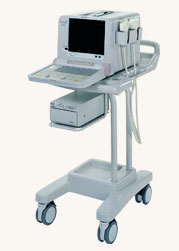Medical Ultrasound Imaging
Wednesday, 8 May 2024
'Convex Transducer' Searchterm 'Convex Transducer' found in 20 articles 1 term [ • ] - 3 definitions [• ] - 16 booleans [• ]Result Pages : • Convex Transducer
Convex transducers are today standard on every new scanner. A convex surface allows the scanning of a larger area with a smaller array. The method of focusing and beam sweeping of a convex or curvilinear / curved array is similar to a linear array transducer, except of the shape of the probe and the sector format of the created image. The better fit to the body, caused by the curved shape with smaller convex contact surface, and the wider field of view further from the transducer face are advantages in abdominal ultrasound. However, also a convex array is often too large to image the heart when probing between the ribs. Caused by combining a large field of view with smallest array size, phased array transducers are the best choice in cardiac ultrasound. See also Curved Transducer. •
The convex shape of the probe allows scanning a larger area than with a smaller array. Convex probes produce sector images. See also Convex Transducer. •
A curved or curvilinear array transducer is similar to a linear array except that the image created has a sector-type format. A curvilinear array gives a large footprint and near field with a wide sector. Usually, curved transducers are described by the radius of curvature in mm. The transducer elements control the characteristics and direction of the sound beam. Curvilinear transducers have a wider field of view from the transducer face. Sector scanners are most useful for cardiac ultrasound examinations where the beam is directed between the ribs to image the heart. Also called convex transducer. •
In the field of medical ultrasound imaging, the term 'probe' specifically refers to the ultrasound transducer and represent the handheld device that emits and receives ultrasound waves during an examination. The probe encompasses various components such as the elements, backing material, electrodes, matching layer, and protective face that are responsible for both emitting and receiving the sound waves. Aperture, known also as the footprint, is the part of the probe that is in contact with the body. When the emitted sound waves encounter body tissues, they generate reflections that are received by the probe, which then generates a corresponding signal. In most cases, the probe emits ultrasound waves for only about 10% of the time and receives them for the remaining 90%. Probes are available in different shapes and sizes to accommodate various scanning situations. The footprint is linked to the arrangement of the piezoelectric crystals and comes in different shapes and sizes e.g. linear array transducer//convex transducer. The transducer plays a huge role in image quality and is one of the most expensive parts of the ultrasound machine. Mechanical probes steer the ultrasound beam driven by a motor and are capable of producing high-quality images, but they are prone to wear and tear. Mechanical probes have been mostly replaced by electronic multi-element transducers, but mechanical 3D probes still remain for abdominal and Ob-Gyn applications. In summary, the terms 'ultrasound transducer,' 'probe,' and 'scanhead' are often used interchangeably to refer to the same component of the ultrasound machine. Probes consist of multiple components and are available in different shapes and sizes depending on the sonographer's needs. See also Handheld Ultrasound, Ultrasound System Performance, Omnidirectional, Probe Cleaning, and Multi-frequency Probe, Further Reading: News & More:
•  From Hitachi Medical Systems America Inc.;
From Hitachi Medical Systems America Inc.;The EUB-405 PLUS ultrasound system is a small portable unit and offers extreme dependability and uncompromising image quality. Compatible with a wide range of transducers, this system is a cost effective solution for a variety of clinical settings. A variety of measurements and calculations including distance, area, circumference, volume, are possible. Device Information and Specification
APPLICATIONS
General purpose, OB, urological
CONFIGURATION
Compact portable system
Dual frequency
Linear, convex, radial, bi-plane, echoendoscope longitudinal
PROBE PORTS
One
OPTIONAL PACKAGE
Cine/multi-memory, digital image storage and transfer via flashcard, cart, second port
WEIGHT
Less than 14 kg
Result Pages : |
Medical-Ultrasound-Imaging.com
former US-TIP.com
Member of SoftWays' Medical Imaging Group - MR-TIP • Radiology TIP • Medical-Ultrasound-Imaging
Copyright © 2008 - 2024 SoftWays. All rights reserved.
Terms of Use | Privacy Policy | Advertise With Us
former US-TIP.com
Member of SoftWays' Medical Imaging Group - MR-TIP • Radiology TIP • Medical-Ultrasound-Imaging
Copyright © 2008 - 2024 SoftWays. All rights reserved.
Terms of Use | Privacy Policy | Advertise With Us
[last update: 2023-11-06 01:42:00]




